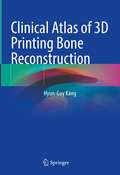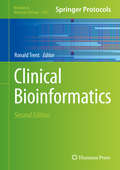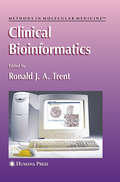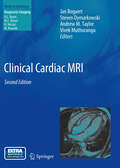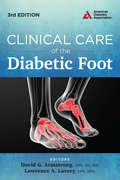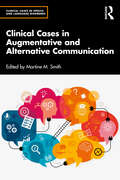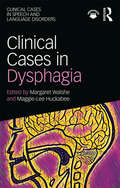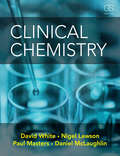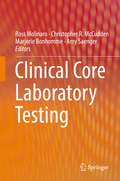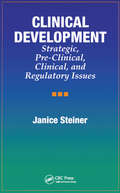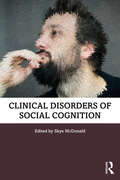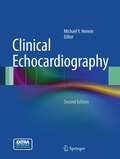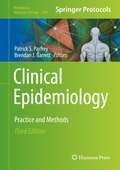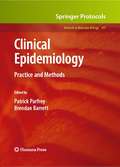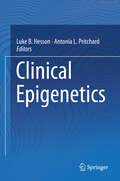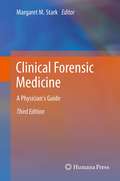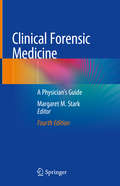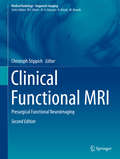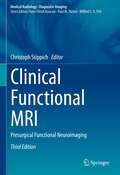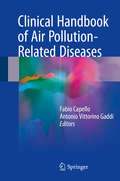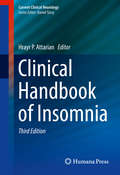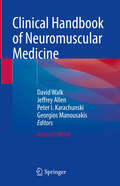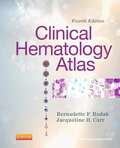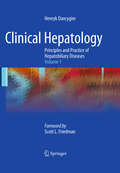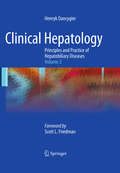- Table View
- List View
Clinical Atlas of 3D Printing Bone Reconstruction
by Hyun-Guy KangThis book provides practitioners with comprehensive guidance on the application of 3D printing technology in the bone reconstruction. The 3D printed implants need to be able to maximize function and minimize complications by reinforcing strength and changing shape beyond anatomically identical design. Many of the clinical cases in this book, including pre-operative images, surgical planning, design and fabrication, 3D printing implants and guides, surgery and postoperative images, will suffice to capture the sensation of the 3D printing bone reconstruction. This book is composed of photos with minimum descriptions so that the readers can develop their imaginative view.
Clinical Bioinformatics (Methods in Molecular Biology #1168)
by Ronald TrentIn Clinical Bioinformatics, Second Edition, leading experts in the field provide a series of articles focusing on software applications used to translate information into outcomes of clinical relevance. Recent developments in omics, such as increasingly sophisticated analytic platforms allowing changes in diagnostic strategies from the traditional focus on single or small number of analytes to what might be possible when large numbers or all analytes are measured, are now impacting patient care. Covering such topics as gene discovery, gene function (microarrays), DNA sequencing, online approaches and resources, and informatics in clinical practice, this volume concisely yet thoroughly explores this cutting-edge subject Written in the successful Methods in Molecular Biology series format, chapters include introductions to their respective topics, lists of the necessary materials and reagents, step-by-step, readily reproducible protocols, and notes on troubleshooting and avoiding known pitfalls. Authoritative and easily accessible, Clinical Bioinformatics, Second Edition serves as an ideal guide for scientists and health professionals working in genetics and genomics.
Clinical Bioinformatics (Methods in Molecular Medicine #141)
by Ronald J.A. TrentWith the ever-increasing volume of information in clinical medicine, researchers and health professionals need computer-based storage, processing and dissemination. In this book, leading experts in the field provide a series of articles focusing on software applications used to translate information into outcomes of clinical relevance. This book is the perfect guide for researchers and clinical scientists working in this emerging "omics" era.
Clinical Cardiac MRI (Medical Radiology)
by Andrew M. Taylor Vivek Muthurangu Jan Bogaert Steven DymarkowskiClinical Cardiac MRI is a comprehensive textbook intended for everyone involved in magnetic resonance imaging of the heart. It is designed both as a useful guide for newcomers to the field and as an aid for those who routinely perform such studies. The first edition, published in 2004-5, was very well received within the cardiac imaging community, and has generally been considered the reference because of its completeness, its clarity, and the number and quality of the illustrations. Moreover, the addition of a CD-ROM showing 50 real-life cases significantly enhanced the value of the book. In this second edition, the aim has been to maintain the same quality while incorporating the newest insights and developments in this rapidly evolving domain of medical imaging. The four editors, all experts in the field, have taken great care to ensure a homogeneous high standard throughout the book. Finally, the selection of 100 real-life cases, added as online material, will further enhance the value of this textbook.
Clinical Care of the Diabetic Foot 3rd Edition
by David G. Armstrong MPH Lawrence A. Lavery DpmThe third edition of Clinical Care of the Diabetic Foot has been fully revised and updated, and continues to be the essential handbook on foot care and the treatment of the diabetic foot. <P><P> The diabetic foot is typically the victim of nerve damage, micro- and macrovascular disease, and faulty healing, mechanisms that without proper care can lead to amputation. More than 80,000 diabetes-related amputations are performed in the United States each year, but non-specialist primary care providers, as well as residents, nurses, and diabetes educators, can help prevent this devastating, life-altering, and expensive complication. Healthcare professionals and medical students alike will find that this concise, well-indexed, and updated guide offers practical advice on detecting and managing diabetes-related foot complications.
Clinical Cases in Augmentative and Alternative Communication (Clinical Cases in Speech and Language Disorders)
by Martine M. SmithClinical Cases in Augmentative and Alternative Communication provides a concise introduction to the rapidly expanding field of augmentative and alternative communication (AAC). It brings together internationally renowned experts in the field to discuss its application and outline key principles of intervention to support communication using AAC. Carefully grounded in evidence-based clinical practice, the book highlights the diversity of potential applications for AAC across a wide range of client groups, including children and adults with developmental disabilities, as well as adults with acquired impairments. Most of the chapters are structured as case reports following CARE guidelines and highlight key principles for intervention that are grounded in clinical practice. The chapters also include reflections on communication through AAC and the valuable contributions that AAC can make in supporting independence and enhancing quality of life. This accessible book is ideal reading for students, novice clinicians in the fields of speech and language therapy or pathology, and professionals who are new to this area of clinical practice.
Clinical Cases in Dysphagia (Clinical Cases in Speech and Language Disorders)
by Margaret Walshe Maggie-Lee HuckabeeDysphagia is a complex condition that can have significant social, developmental and psychological effects. Alongside the physiology and pathophysiology of the condition, dysphagia can rob patients of the most basic pleasures, such as eating and drinking, causing ongoing difficulties for individuals in social situations throughout the lifespan. As an acknowledged component of evidence-based practice, the humble case report encourages clinical reflection and may be the spark that generates new thinking and motivation for future research. Clinical Cases in Dysphagia provides an opportunity to gain insight into the unique and varied presentation and management of dysphagia across a range of different conditions. With chapters provided by expert clinicians and based on clinical examples ‘from the trenches’, the reader may gain insights into their own practice patterns, refining their clinical problem solving and valuing the education that is offered to each of us by our patients. With additional online resources to support the case-based approach, the book emphasizes the importance of multidisciplinary care and reflects everyday clinical practice, making it a must-read for clinicians and students.
Clinical Chemistry
by David White Nigel Lawson Daniel Mclaughlin Paul MastersClinical Chemistry is a comprehensive textbook covering the area of medical science variously known as chemical pathology, clinical chemistry, medical biochemistry and clinical biochemistry. The biochemical processes and physiological interrelationships, of tissues, organs and molecules are discussed in the context of disease processes and related to the diagnosis, monitoring, and management of disease. Also included are analytical processes, such as immunoassay, and how these relate to clinical practice. Although the emphasis of this book is clinical biochemistry, some chapters include sections on haematology, radiology and microbiology where this helps in the understanding of disease processes. The increasing use of the techniques of molecular biology and genetics in the investigation of disease is acknowledged also by appropriate inclusion of these disciplines in a number of chapters. Standard International (SI) units of measurement are used throughout, but for tests where non-SI units are in common use as well as SI units both sets of units are quoted.
Clinical Core Laboratory Testing
by Ross Molinaro Christopher R. Mccudden Marjorie Bonhomme Amy SaengerThe clinical laboratory is often known as a "black box" to nurses, physicians, and surgeons, but this concise book removes the veil by covering all the pertinent aspects of the clinical laboratory. This book bridges between medicine and chemistry by offering an overview to a clinical laboratory's structure and function, the importance of laboratory utilization and test ordering, as well as pre-analytical, analytical, and post-analytical issues of importance to recognize in any clinical laboratory. An interactive FAQ and a detailed index are also available.
Clinical Development: Strategic, Pre-Clinical, and Regulatory Issues
by Janice SteinerEveryone involved in pre-clinical, clinical, formulation, development and regulatory affairs will find Clinical Development a valuable resource. The book provides expert advice on ways to reduce delays and lost market opportunities, minimize development time, better understand the process and regulatory requirements, and plan and analyze clinical development and testing programs. The author combines text, graphs, and charts to show how a company moves a product through the complex process from discovery to market. The result is a complete analysis of the drug development process in easy-to-understand language and easy-to-implement action steps.
Clinical Disorders of Social Cognition
by Skye McDonaldClinical Disorders of Social Cognition provides contemporary neuroscientific theories of social cognition in a wide range of conditions across the lifespan. Taking a trans-diagnostic approach to understanding these disorders, it discusses how they present in different conditions, ranging from brain injury to neurodevelopmental disorders, psychiatric conditions and dementia. Social cognitive disorders directly impact upon individuals’ work, leisure and social functioning. This book also collates and critiques the best and most useful assessment tools across the different disorders and coalesces research into intervention strategies across disorders to provide practical information about how such disorders can be assessed and treated so individuals can have meaningful, effective and satisfying social interactions. This book is essential reading for clinicians who work with people with clinical disorders and who are looking for new knowledge to understand, assess and treat their clients with social cognitive impairment. It will also appeal to students and professionals in clinical neuropsychology, speech and language pathology and researchers who are interested in learning more about the social brain and understanding how evidence from clinical conditions can inform this.
Clinical Echocardiography
by Michael Y. Henein Michael Rigby John R. Pepper Mary Sheppard-Integrates the investigation of the echocardiographic findings with the pathologic, clinical and surgical aspects of heart disease -Includes stunning color echocardiographic images of various heart diseases with reference to their pathologic appearance and physiology -Includes clinical comments on patient management, which is not included in other echocardiography texts
Clinical Epidemiology: Practice and Methods (Methods in Molecular Biology #2249)
by Patrick S. Parfrey Brendan J. BarrettThis third edition volume expands on the previous editions with updated chapters on longitudinal studies, randomized trials, evidence-based decisions making, and a new section on changing health-related behaviors. The chapters in this book are organized into six parts: Part One focuses on framing clinical research questions and choosing a suitable design; biases that may occur in clinical research; and the ethics associated with doing conducting research on humans. Parts Two through Four discuss designs, measurements, and analysis that pertain to evaluation of risk in longitudinal studies; assessment of therapy in controlled trials; and evaluation of diagnostic tests. Part Five presents methods used in various components of evidence-based decision-making; and Part Six highlights interventions focused on changing health-related behaviors. Written in the highly successful Methods in Molecular Biology series format, chapters include introductions to their respective topics, lists of various types of bias, step-by-step, readily reproducible protocols for different research designs, and tips on troubleshooting and avoiding known pitfalls.Cutting-edge and thorough, Clinical Epidemiology: Methods and Protocols, Third Edition is a valuable resource for clinicians and researchers who want to expand their works to humans and use their findings in the health system.
Clinical Epidemiology: Practice and Methods (Methods in Molecular Biology #473)
by Brendan Barrett Patrick ParfreyClinical epidemiology provides the scientific basis for the practice of medicine due to its focus on the diagnosis, prognosis and management of human disease using appropriate research design, measurement and evaluation. In Clinical Epidemiology: Practice and Methods, leading experts contribute selections intended to educate researchers on how best to undertake clinical research. Divided into two categories, the volume first covers issues of design, measurement and analysis associated with various research designs, then continues with methods to better inform medical decision-making, including aggregation of multiple studies using meta-analysis, health economics, clinical practice guidelines and health technology assessment. As a part of the highly successful Methods in Molecular BiologyTM series, this comprehensive text collects the kind of detailed, up-to-date information and implementation advice that is crucial for getting optimal results. Essential and advantageous, Clinical Epidemiology: Practice and Methods is an ideal reference for medical practitioners, basic scientists and allied health professionals who desire to improve clinical outcomes.
Clinical Epigenetics
by Luke B. Hesson Antonia L. PritchardIn genetic pathology, epigenetic testing is rare and under utilised. In this book, we introduce epigenetics to a non-expert scientific audience and describe current and future clinical utility of epigenetic testing. By focussing on epigenetics in human disease this book will guide professionals (scientists and clinicians) to understand how epigenetics is relevant in a clinical context, and to implement epigenetic testing in diagnostic laboratories. The book begins with a historical perspective of genetics and epigenetics and describes the work of pioneers who have helped shape these fields. The various mechanisms by which epigenetics can regulate the function of the genome is described. These include DNA methylation, histone modifications, histone variants, nucleosome positioning, cis-regulatory elements, non-coding RNAs and the three-dimensional organisation of chromatin in the nucleus. These are discussed in the context of embryological development, cancer and imprinting disorders, and include examples of epigenetic changes that can be used in diagnosis, prediction of therapeutic response, prognostication or disease monitoring. Finally, for those wishing to implement epigenetic testing in a diagnostic setting, the book includes a case study that illustrates the clinical utility of epigenetic testing.
Clinical Forensic Medicine: A Physician's Guide (Forensic Science And Medicine Ser.)
by Margaret M. StarkThe publication of this third edition of the definitive text on clinical forensic medicine comes at an exciting time for a subject now gaining recognition as a speciality in the medical establishment. This growing acknowledgement reflects the fact that increasing numbers of health professionals are becoming engaged in general forensic services. Nurses and paramedics are more involved than ever in custody care, while nurses themselves are conducting more examinations in cases involving alleged sexual offences. Thus it is vital that those caring for this vulnerable group of patients (whether detainees or complainants) have the tools to master this specialist set of skills. All the chapters in this new edition have been fully updated, with some undergoing extensive revision. Recent developments in child protection protocols have prompted a major rewrite of the chapter on non-accidental injury, and the text now includes a specific chapter on the use of the TASER. Other aspects of restraint are now dealt with separately. The material on care of detainees and fitness for interview has been split into individual chapters to allow a more comprehensive discussion of the issues. In addition, new authors have joined the team of contributors, facilitating a wider range of international perspectives. From its chapters on the history and core principles of clinical forensic medicine, right up to the text's discussion of substance misuse and deaths in custody, this volume remains the gold standard source for health professionals whose working lives bring them into contact with those in the law enforcement arena.
Clinical Forensic Medicine: A Physician's Guide (Forensic Science And Medicine Ser.)
by Margaret M. StarkThis updated volume on clinical forensic medicine covers the topics required for forensic healthcare professionals working in general forensic medicine and sexual offence medicine. All chapters have been reviewed and revised to reflect how the provision of forensic medical services has changed since the previous edition with multidisciplinary teams working in the custodial environment, comprising doctors, nurses, and paramedics and those practitioners providing sexual offence examinations.New and updated topics include: the increasing importance of photo documentation by health care professionals; updated information on strangulation, torture; a review of bite mark injuries; the explosion of Novel Psychoactive Substances worldwide; the changing patterns of deaths in custody and deaths following police contact; and the introduction in various jurisdictions of legal limits for drugs based on zero tolerance or a risk based approach.Written by a team of experts, the new edition of this book is a valuable resource for forensic healthcare professionals including doctors, nurses and paramedics working in general forensic medicine and sexual offence medicine, as well as emergency physicians, pediatricians and gynaecologists.
Clinical Functional MRI: Presurgical Functional Neuroimaging (Medical Radiology)
by Christoph StippichThe second, revised edition of this successful textbook provides an up-to-date description of the use of preoperative fMRI in patients with brain tumors and epilepsies. State of the art fMRI procedures are presented, with detailed consideration of practical aspects, imaging and data processing, normal and pathological findings, and diagnostic possibilities and limitations. Relevant information on brain physiology, functional neuroanatomy, imaging technique, and methodology is provided by recognized experts in these fields. Compared with the first edition, chapters have been updated to reflect the latest developments and in particular the current use of diffusion tensor imaging (DTI) and resting-state fMRI. Entirely new chapters are included on resting-state presurgical fMRI and the role of DTI and tractography in brain tumor surgery. Further chapters address multimodality functional neuroimaging, brain plasticity, and pitfalls, tips, and tricks.
Clinical Functional MRI: Presurgical Functional Neuroimaging (Medical Radiology)
by Christoph StippichThe third, revised edition of this successful book describes up-to-date preoperative fMRI and complementary advanced imaging methods (DTI, MEG, PET, etc.) to diagnose and treat patients with brain tumors and epilepsy. It presents the state of the art fMRI and complementary imaging procedures and discusses practical aspects, imaging and data processing steps, normal and pathological findings, and diagnostic possibilities and limitations. Experts in the field explain relevant information on brain physiology, functional neuroanatomy, and imaging techniques.All chapters of the second edition have been fully updated to reflect the latest developments. Multimodality functional neuroimaging was rewritten by new authors. Further chapters address brain plasticity, and pitfalls, tips, and tricks.
Clinical Handbook of Air Pollution-Related Diseases
by Fabio Capello Antonio Vittorino GaddiThis book examines in detail the clinical implications of those diseases that either are primarily triggered by air pollution or represent direct consequences of air pollutants. The aim is to provide medical practitioners with practical solutions to issues in diagnosis and treatment while simultaneously furnishing other interested parties with crucial information on the field. The book introduces the concept that air pollution-related diseases constitute a new class of pathologies. A wide range of conditions mainly attributable to air pollution are discussed, covering different body systems and pollution impacts in subsets of the population. In addition to presenting state of the art overviews of clinical aspects, the book carefully examines the implications of current knowledge for social and public health strategies aimed at disease prevention and prophylaxis. The Clinical Handbook of Air Pollution-Related Diseases will greatly assist doctors and healthcare workers when dealing with the consequences of air pollution in their everyday practice and will provide researchers, industry, and policymakers with valuable facts and insights.
Clinical Handbook of Insomnia (Current Clinical Neurology)
by Hrayr P. AttarianExpanding on the critical contributions of previous editions, this updated and comprehensive resource covers the latest diagnostic criteria of insomnia. The book is thematically divided into two parts. The first section consists of chapters on nomenclature, epidemiology, pathophysiology, diagnosis and differential diagnosis, complications and prognosis and treatment both pharmacological and behavioral. The second features chapters on insomnia in special populations, including ones on children and adolescents, cancer sufferers and survivors, in pregnancy, in menopausal women and in patients with neurological disorders and those with psychiatric illnesses. This third edition fills an important niche in the medical literature by addressing insomnia in its multiple forms, summarizes the findings published in different medical journals, and presents these to the practicing health care provider in an easily accessible format.
Clinical Handbook of Neuromuscular Medicine
by Jeffrey Allen David Walk Peter I. Karachunski Georgios ManousakisThis updated and expanded new edition provides a concise introduction to the Neuromuscular Medicine subspecialty of neurology for residents and fellows. It's organized by disease states and includes chapters on diagnostic and management tools of particular relevance, including muscle and nerve biopsy, EMG and nerve conduction studies, neuromuscular genetic testing, and rehabilitation interventions of particular relevance to this patient population. New to this edition are a section on neuromuscular ultrasound, a listing of validated outcome measures and functional scales in neuromuscular disease, interim advances in treatments, advances in understanding of mechanisms of disease, an expanded section on symptom and disability management, a single source listing outcome measures and functional scales, and a discussion on the growing importance of neuromuscular ultrasound and MR imaging. An indispensable guide for neurology residents and fellows, neuromuscular medicine fellows starting their training, practicing neurologists, and providers in related fields that have high exposure to neuromuscular disease populations.
Clinical Hematology Atlas (Fourth Edition)
by Bernadette F. Rodak Jacqueline H. CarrAn excellent companion to Rodak's Hematology: Clinical Principles & Applications, this atlas is ideal for helping you accurately identify cells at the microscope. It offers complete coverage of the basics of hematologic morphology, including examination of the peripheral blood smear, basic maturation of the blood cell lines, and discussions of a variety of clinical disorders. Over 400 photomicrographs, schematic diagrams, and electron micrographs visually clarify hematology from normal cell maturation to the development of various pathologies. Normal Newborn Peripheral Blood Morphology chapter covers the unique normal cells found in neonatal blood. A variety of high-quality schematic diagrams, photomicrographs, and electron micrographs visually reinforce your understanding of hematologic cellular morphology. Spiral binding and compact size make this book easy to use in a laboratory setting. Coverage of common cytochemical stains, along with a summary chart for interpretation, aids in classifying malignant and benign leukoproliferative disorders. Morphologic abnormalities are presented in chapters on erythrocytes and leukocytes, along with a schematic description of each cell, to provide correlations to various disease states. Body Fluids chapter covers the other fluids found in the body besides blood, using images from cytocentrifuged specimens. Updated information on the subtypes of chronic lymphocytic leukemia (CLL) helps you recognize variant forms of CLL you may encounter in the lab.
Clinical Hepatology: Principles and Practice of Hepatobiliary Diseases: Volume 1 (Mount Sinai Expert Guides)
by Henryk DancygierClinical Hepatology - Principles and Practice of Hepatobiliary Diseases provides clear and comprehensive coverage of the etiology, mechanisms of disease, diagnosis, and practical management of the entire spectrum of liver and biliary disorders. It also affords an excellent, evidence-based review of the rapidly expanding field of hepatobiliary diseases.
Clinical Hepatology: Principles and Practice of Hepatobiliary Diseases: Volume 2 (Mount Sinai Expert Guides)
by Henryk DancygierClinical Hepatology - Principles and Practice of Hepatobiliary Diseases provides clear and comprehensive coverage of the etiology, mechanisms of disease, diagnosis, and practical management of the entire spectrum of liver and biliary disorders. It also affords an excellent, evidence-based review of the rapidly expanding field of hepatobiliary diseases.
